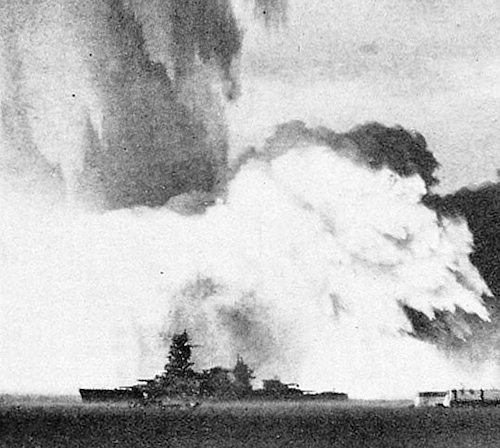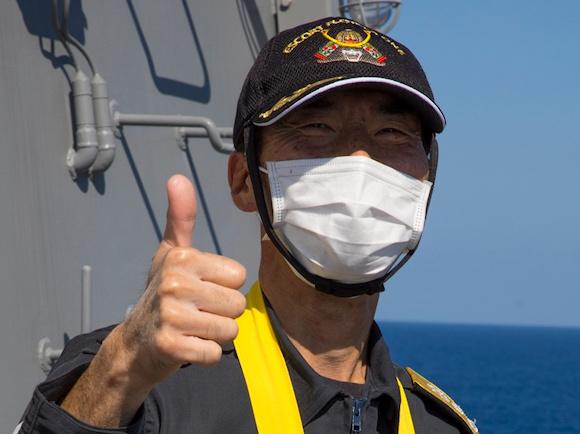It is strange how historical courses and resorts chase each other, on the seas of the world ... since the end of the Second World War many things have changed in the Pacific and, after a period of US monopoly, in recent years old and new maritime powers have renewed their constructions. , building aircraft carrier units, wanting to confirm the importance of the air-naval component in the maritime operations of the third millennium.
The latest events were the operations of two F-35Bs of the United States Marine Corps (USMC), belonging to the Marine Fighter Attack Squadron 242 based in Japan, aboard the Japanese aircraft port JS Izumo.
The importance of the air-naval component: a strong point of the Japanese navy that has always been
During the last world war, Japan proved to have a respectable air and naval force both from a technological and tactical point of view. The general staff of the Japanese navy proved to be efficient and with a strategic vision centered on the use of different aircraft carriers (the Kido Butai).
After the defeat, the Imperial Japanese Navy (or 日本 海軍 Nippon Kaigun for "Navy of the Empire of Greater Japan") was dissolved in 1947 by the acceptance of the Potsdam Declaration.

The ships were disarmed and some of them, such as the battleship Nagato (pictured during the second atomic test in Bikini Atoll, ed), were acquired by the allied powers as a repair of war damage. The remaining ships were used in support tasks and, in particular, for the demining of the thousands of naval mines laid in the area around the Japanese coasts.
The future of the fleet was limited by the new Japanese Constitution, signed in 1947, which in article 9 specified that the Japanese people forever renounced war as the sovereign right of the nation and the threat or use of force as a means to resolve the international disputes. This meant that Japan was allowed to maintain military forces for self-defense purposes only. A limitation that was already foreseen temporary, given the course of the policy of the new Japan increasingly oriented towards a preferential relationship with the United States.
On the other hand, the Americans had maintained a military presence on the territory, they had seen a certain utility in favoring the development in the region of friendly forces capable of contributing to the maintenance of maritime security.
In 1952, the Coastal Safety Force, established within the Maritime Safety Agency, incorporating the fleet of dredging units with the few offshore units, mostly destroyers, provided by the cooperation program with the United States.
In 1954, following the approval of the new law on self-defense forces, the JMSDF (Japan Maritime Self-Defense Force) was created as a naval branch of the Japanese Self-Defense Forces (JSDF).
 In 1956, the Japanese shipbuilding industry built its first domestically produced destroyer since World War II, theharukaze (photo).
In 1956, the Japanese shipbuilding industry built its first domestically produced destroyer since World War II, theharukaze (photo).
From that moment the Japanese units became, similar to those of NATO member countries, an important component for the fight against Soviet submarines in the Pacific. In that period, important unit projects were also launched to be used in naval patrol.
After the end of the Cold War, the JMSDF began to send its units to the conflict zones, actively participating in both international operations, under the aegis of the United Nations, and in coalitions in the context of maritime security operations (anti-piracy).
In 1993 the JMSDF commissioned its first destroyer, Kongō, equipped with the Aegis integrated combat system, a unit that was then also used in joint naval exercises with the United States. The JMSDF continued in those years to send a certain number of destroyers to the Indian Ocean in escort activities for the allied ships as part of the operation. Enduring Freedom of the United Nations.
 There were moments of great tension, suffice it to recall the operations against the North Korean forces, when Japanese units engaged and sank, on December 22, 2001, a North Korean spy ship in the Amami-Ōshima clash. It was a confrontation, which lasted about six hours, between four units of the Japanese Coast Guard and a North Korean armed ship, near the island of Amami-Ōshima, in the East China Sea. The North Korean spy trawler refused to stop and a violent firefight began which resulted in the sinking of the trawler.
There were moments of great tension, suffice it to recall the operations against the North Korean forces, when Japanese units engaged and sank, on December 22, 2001, a North Korean spy ship in the Amami-Ōshima clash. It was a confrontation, which lasted about six hours, between four units of the Japanese Coast Guard and a North Korean armed ship, near the island of Amami-Ōshima, in the East China Sea. The North Korean spy trawler refused to stop and a violent firefight began which resulted in the sinking of the trawler.
The event occurred beyond Japanese territorial waters but within the Exclusive Economic Zone (EEZ), where Japan can exercise exclusive rights in fishing and mining.
Hunt down aircraft ports
During the operations of recent years there has been a reinterpretation of the operational concept of the Japanese navy, culminating in the planning of a new class of "helicopter carriers", declared as a class destroyer Hyuga but in fact then classified as helicopter carriers from Lloyd's Register.
 This aroused a number of controversies since, again referring to the aforementioned article 9, the use of aircraft carriers was seen as wanting to reacquire offensive capacity. The JMDF retorted that, similar to the US Navy, which considered the large aircraft carriers as attack aircraft carriers while the smaller aircraft carriers (aircraft carriers) as anti-submarine units, in fact the new construction was identified in a helicopter carrier therefore with tasks not offensive.
This aroused a number of controversies since, again referring to the aforementioned article 9, the use of aircraft carriers was seen as wanting to reacquire offensive capacity. The JMDF retorted that, similar to the US Navy, which considered the large aircraft carriers as attack aircraft carriers while the smaller aircraft carriers (aircraft carriers) as anti-submarine units, in fact the new construction was identified in a helicopter carrier therefore with tasks not offensive.
In November 2009, the JMSDF announced plans for a larger "helicopter carrier", the class helicopter destroyer Izumo. The unit was launched on August 6, 2013 and has recently completed the first major maintenance stop (costing over 30 million dollars) which allowed the boarding of fixed-wing aircraft. Thanks to the experiences acquired, the sister ship of theIzumo, Kaga, it will probably be modified starting this year.
But we come to the news that seems to conclude a long period since the war: two USMC F-35Bs successfully landed on the Izumo, using the standard aircraft maneuver. short take-off and vertical-landing (STOVL). For the layman, in simple terms, the pilot converts the plane into mode hover as it flies alongside the aircraft carrier, then moves sideways onto the deck before landing.

The operations were successful even if, it would seem that the two planes, approaching on the left side of the Izumo, had some problems to avoid the bow gun. A maneuver that could be dangerous in certain operational situations for which it has already been predicted that in the next works, in 2024, the gun will be moved, effectively freeing up space on the deck for flight operations.
In a nutshell, the JS Izumo has been shown to be capable of performing short take-off and vertical landing (VSTOL) aircraft operations, an important factor in carrying out defensive and offensive air and naval operations at sea.
This new capability travels in parallel with the Japanese Defense's acquisition of 42 F-35Bs to operate from Izumo e Kaga that will embark the first aircraft from 2023.
Meanwhile, the collaboration with USMC aircraft will allow the Japanese Navy to train Izumo flight specialists pending the entry into service of the Japanese F-35Bs.
The two renewed Japanese aircraft carriers will certainly find a useful use in the Pacific where we are witnessing an offensive expansion of the Chinese navy which has two aircraft carriers (a third is being built). In a hypothetical conflict, the aircraft carriers will therefore return to being significant for the control of the routes, extending the long arm of their offensive capabilities for a contest that will still be fought in the skies of the high seas.
A capability that hopefully will also be consolidated in the Italian navy, putting an end to the current stalemate.

Photo: US Marine Corps / Japan Maritime Self-Defense Force
(article originally published on https://www.ocean4future.org)












